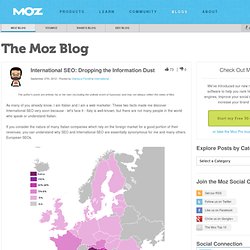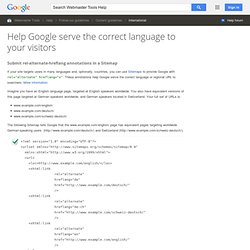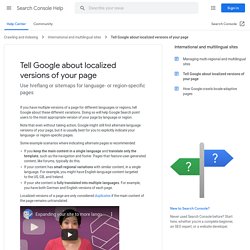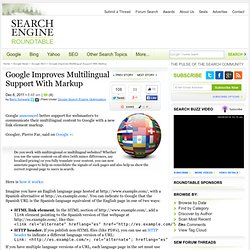

Official Google Advice On Internationalizing Your Home Page. Google has published their official advice on the Google Webmaster Central blog on how to handle your home page when your web site serves multiple languages and countries.

Zineb Ait Bahajji and Gary Illyes, Google Webmaster Trends Analysts, wrote the post together trying to break out the possibilities into three categories: (1) Having one home page that shows all users, no matter of language or location that same home page. International SEO FAQs By Google. International SEO: Dropping the Information Dust. The author's posts are entirely his or her own (excluding the unlikely event of hypnosis) and may not always reflect the views of Moz.

As many of you already know, I am Italian and I am a web marketer. These two facts made me discover International SEO very soon because - let's face it - Italy is well-known, but there are not many people in the world who speak or understand Italian. If you consider the nature of many Italian companies which rely on the foreign market for a good portion of their revenues, you can understand why SEO and International SEO are essentially synonymous for me and many others European SEOs.
This map explains why I must be an International SEO. Image by: This explains my interest in how search engines treat the problems associated with multi-country and multi-lingual sites. Many small and medium-sized businesses now have the desire to engage in a globalized market. My Q&A duties as SEOmoz Associate have made me notice the increased interest in International SEO. International SEO: Where to Host and How to Target - Whiteboard Friday.
International SEO is big business, and big business equals big websites.

It can be really confusing when you have to cater to a target audience that is the entire world: you know that people from different countries and cultures are going to be looking for different things. We've had a lot of PRO members' Q&A questions come in about this issue lately, so this week, Rand helps us figure out how to deal! He'll show us the pros and cons of using subdomains, subdirectories, and ccTLDs to organize a site's infrastructure and handle different content for different audiences/countries/pandas/orangutans.
Howdy, SEOmoz fans. Multi-regional and multilingual sites - Webmaster Tools Help. If your site offers different content to users in different languages, countries, or regions, you can optimize Google Search results for your site.

Background: A multilingual website is any website that offers content in more than one language. For example, a Canadian business with English and French versions of its site. Google Search tries to find pages that match the language of the searcher. Working with multi-regional websites. Webmaster Level: Intermediate Did you know that a majority of users surveyed feel that having information in their own language was more important than a low price?

Living in a non-English-speaking country, I've seen friends and family members explicitly look for and use local and localized websites—properly localized sites definitely have an advantage with users. Google works hard to show users the best possible search results. Many times those are going to be pages that are localized, for the user's location and/or in the user's language. If you're planning to take the time to create and maintain a localized version of your website, making it easy to recognize and find is a logical part of that process. International SEO: Using XML Sitemaps hreflang= for Geotargeting? Beware of the Kinks. We recently had a bit of a head-scratcher with a new e-commerce client and problems with geo-targeting the correct site to the correct region.

Basically, the correct site wasn’t targeting the correct region and in most cases “.com” seemed to rank vaguely well everywhere; with the .co.uk and .com.au sites nowhere in their respective regions. The client is a small business with fairly low average sale values that ships to just these three English speaking countries referenced. Therefore, SEO director Peter Handley who was in charge of the project, talked through a number of solutions with the client, such as one-site-select-currency-options at payment stages or keeping the multiple TLDs but really changing up the content. In each case, however, the client had tried various solutions before and nothing seemed to work or pose a sensible solution for them when considered against the size of their site and the size of their operation.
Sitemaps: rel="alternate" hreflang="x" - Webmaster Tools Help. If your site targets users in many languages and, optionally, countries, you can use Sitemaps to provide Google with rel="alternate" hreflang="x".

These annotations help Google serve the correct language or regional URL to searchers. More information. Imagine you have an English language page, targeted at English speakers worldwide. You also have equivalent versions of this page targeted at German speakers worldwide, and German speakers located in Switzerland. How to Use Multiple Sitemaps on One Domain for Geo-targeting. Working with websites that targets several countries is always challenging, especially from an SEO point of view, people just don’t seem to get that doing SEO in different countries goes way beyond different languages.

I would go as far as to say there are probably more website struggling with geo targeting issues in one form or another than it is websites that are all ok and ranking in all the relevant countries they are targeting. If you can imagine that the different Google TLD’s are people, you have Francois (Google.fr), Ingrid (Google.no), Helmut (Google.de) and so on. They all want to rank the most relevant websites highly in their relevant countries. How do they do that? Well, they need to find a way to separate the listings, making sure that a website selling iPhones but only to Helmut’s friends doesn’t end up on Ingrid’s list.
The obvious number one rule of differentiation is (1.) Rel="alternate" hreflang="x" - Webmaster Tools Help. Add <link rel="alternate" hreflang="lang_code"...

> elements to your page header to tell Google all of the language and region variants of a page. This is useful if you don't have a sitemap or the ability to specify HTTP response headers for your site. Each variation of the page should include a set of <link> elements in the <head> element, one link for each page variant including itself. The set of links is identical for every version of the page. See the additional guidelines. Here is the syntax of each link element: A Simple Guide to Using rel="alternate" hreflang="x" The world is shrinking and with it the need to support content for more users means supporting more languages.
Supporting multiple languages on websites is nothing new, but with browser and search engine technology starting to rely on structured data, it has never been more important to make sure you are using the correct markup. This is where rel="alternate" hreflang="x" comes in handy. Simply put, when used correctly, this specification element helps Google index and serve the localized version of your content to users who require an alternate language version. The best use of this tag is in instances where you have the same or regionally specific content in another language on the same website.
Google Adds hreflang Link Element For Multilingual Pages. Google announced better support for webmasters to communicate their multilingual content to Google with a new link element markup.

Googler, Pierre Far, said on Google +: Do you work with multiregional or multilingual websites? Whether you use the same content on all sites (with minor differences, say localized pricing) or you fully translate your content, you can now annotate pages to help us consolidate the signals of such pages and also help us show the correct regional page to users in search.
Canonical vs. Hreflang. Google clarifies webmaster questions around potential conflicting nature of rel canonical and hreflang annotation. Briefly about rel=”alternate” hreflang=”x” Websites which serve the same content in multiple languages can utilise the rel=”alternate” hreflang=”x” annotations to help Google decide which version to serve to which language group. This applies in cases of translated page template in blogs and comment features, substantially similar content with minor variations such as currency or in case of fully translated content. Here are a few examples: Website A: uk.dejanseo.com (English Language, GB users) Google Says You Can Use Different Titles Tags For Language Specific Versions. This might be an obvious point to many SEOs but Pierre Far from Google clarified that if you have specific landing pages for the same product but targeting different languages/countries, you can change the title tag of the page without concern.
Pierre Far from Google posted this on Google+ saying: In my last webmaster office hours hangout I got an interesting question: When a webmaster uses rel-alternate-hreflang annotations to mark up a cluster of equivalent pages that target different language-country combinations, can the titles be different for each country? The answer is yes, use a title that makes sense for your users and your site. I go more into detail about how to handle these specialized annotations over here. HREFLANG Markup Testing - It Works! SharebarVote on Hacker News A month or so ago Google announced they are now supporting the HREFLANG markup for translated content that they used to mark as duplicate.
I had just completed an international audit for one of my enterprise clients, so I was interested to do some testing on this to see what effect it might have. The results are very interesting! The Tests I did two different tests. Over the course of the next week or so, I published Canonical Delays with Googlebot and The Power of Guest Blogging. Here’s where the test came in: For the Canonical Delays post, I added the HREFLANG markup to the post, with en-ES pointing to Etiqueta Canonical Retrasa con Googlebot en la Web Contra Indice Movil. Getting hreflang Right: Examples and Insights for International SEO. The author's posts are entirely his or her own (excluding the unlikely event of hypnosis) and may not always reflect the views of Moz.
Most of us will remember the days in SEO where geotargeting was nearly impossible, and we all crawled to the shining example of Apple.com as our means of showcasing what the correct search display behaviour should be. Well, most of us weren't Apple, and it was extremely difficult to determine how to structure your site to make it work for international search. Hreflang has been a blessing to the SEO industry, even though it's had a bit of a troubled past.
There's been much confusion as to how hreflang annotations should work, what is the correct display behaviour, and if the implementation requires additional configuration such as the canonical tag or WMT targeting. This isn't a beginner- or even intermediate-level post, so if you don't have a solid feel for hreflang already, I'd recommend reading through Google's documentation before diving in. Getting A Better Understanding Of Hreflang. Many SEOs start off by looking after local clients. Richard Hearne - Google+ - Question for +John Mueller and/or +Pierre Far regarding… Dealing with Personalized Search [Infographic] Melissa Fach previously shared a great infographic on the public perception of personalized search here at SEJ. According to the data cited, 65% of search users are against the push towards personalized information in search results. How Different Languages Can Help in SEO. Let’s start the conversation with a simple question: What we like about search engines (like Google)?
Well, it understands what we mean and returns exactly what we want.